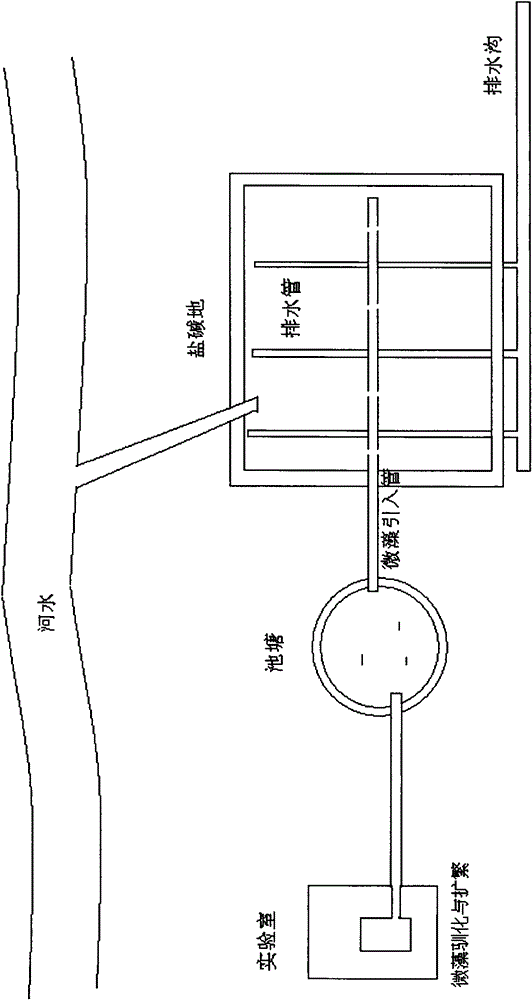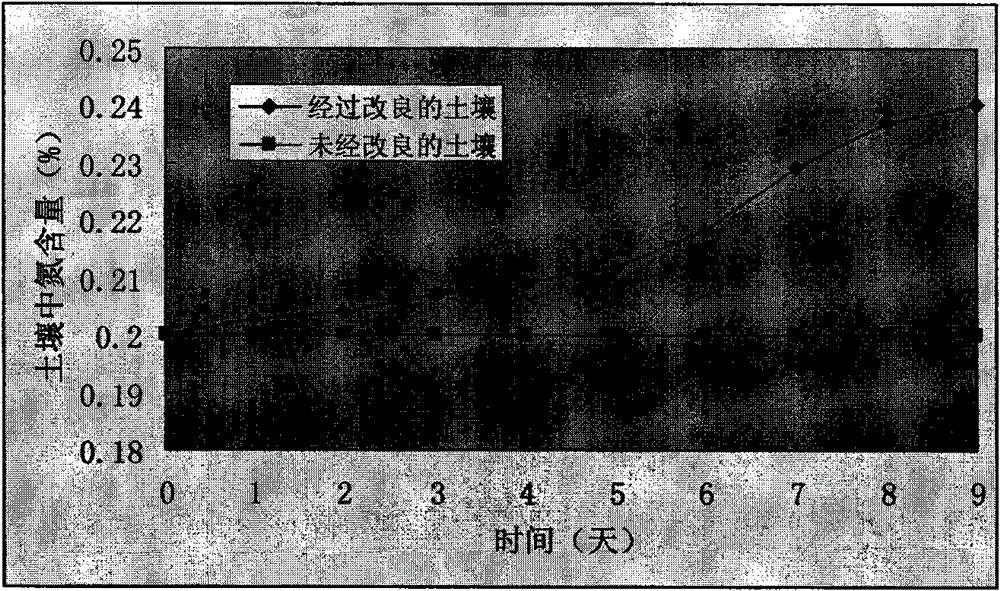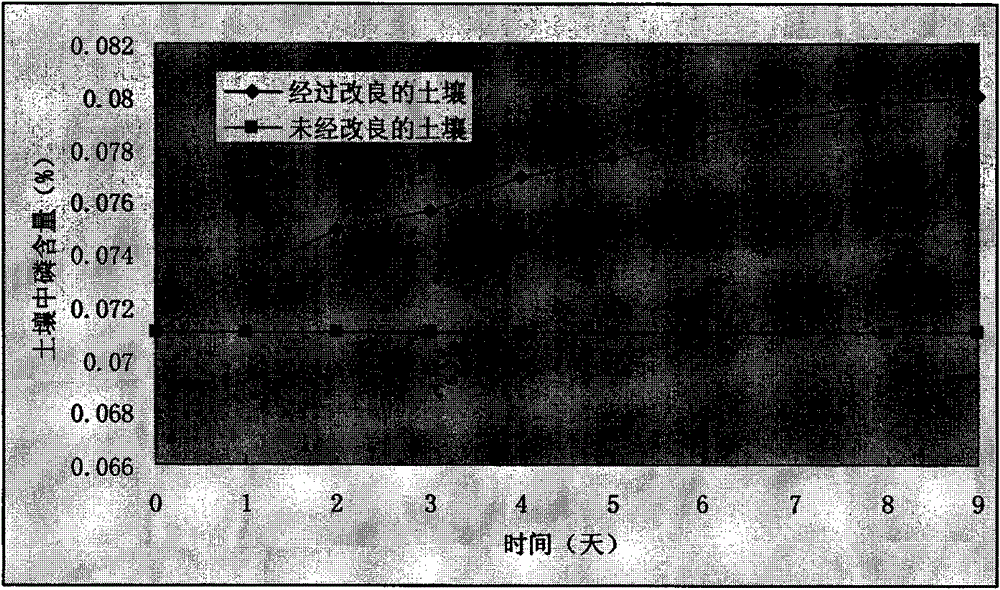Method for domesticating saline land by microalgae
A technology of saline-alkali land and microalgae, applied in the direction of microorganism-based methods, chemical instruments and methods, biochemical equipment and methods, etc., can solve the problems of lack of soil nutrients, large material and financial resources, high treatment costs, etc., and reduce treatment costs Cost, Fertility increase, Effect of increasing microalgae biomass
- Summary
- Abstract
- Description
- Claims
- Application Information
AI Technical Summary
Problems solved by technology
Method used
Image
Examples
Embodiment 1
[0038] Use Cylindrosporium to treat the saline-alkali land around Canglang Canal in Binhai New Area, Tianjin. The soil in this area contains about 0.2% nitrogen, 0.071% phosphorus, 1.5% salt, and 0.6% potassium. , for mild saline-alkali land, the better treatment time is from March to June in spring.
[0039] Step 1. Laboratory algae cultivation
[0040] Prepare the basal medium for cultivating Cylindrospora, the formula of FN30 medium is:
[0041] Ammonium nitrate 0.5-4g / L Sodium chloride 0.25-2.0g / L
[0042] Potassium dihydrogen phosphate 0.01-0.09g / L Magnesium sulfate 0.01-0.05g / L
[0043] Calcium chloride 0.01-0.05g / L Sodium acetate 0.005-0.03g / L
[0044] Urea 0.02-0.08g / L Trace elements 0.5-2ml / L
[0045] Wherein the trace element preparation method is:
[0046] Ferric chloride 4-7mg Sodium molybdate 0.1-0.4mg
[0047] Manganese Chloride 1-5mg Disodium EDTA 40-95mg
[0048] Zinc sulfate 0.3-1.5mg Cobalt chloride 0.02-0.2mg
[0049] Add distilled water to make up t...
Embodiment 2
[0076] Use Nostoc algae in the saline-alkali area around Yantai, Shandong. The soil nitrogen content in this area is about 0.17%, phosphorus content is about 0.073%, salt content is about 2.3%, and potassium content is about 0.52%. It is a relatively moderate saline-alkali land , the better processing time is from March to June in spring.
[0077] Step 1. Laboratory algae cultivation
[0078] Prepare the basal medium for cultivating Nostoc, the formula of FN31 medium is:
[0079] Potassium nitrate 0.05-0.5g / L Calcium chloride 0.003-0.03g / L
[0080] Dipotassium hydrogen phosphate 0.01-0.8g / L Sodium chloride 0.25-2.0g / L
[0081] Potassium dihydrogen phosphate 0.07-0.3g / L Ferric chloride 0.001-0.01g / L
[0082] Magnesium Sulfate 0.02-0.06g / L Naphthaleneacetic Acid 0.2-0.6mg / L
[0083] Trace elements 0.5-2ml / L
[0084] Wherein the trace element preparation method is:
[0085] Boric acid 150-500mg Copper sulfate 2-10mg
Embodiment 3
[0113] Spirulina is used to treat the saline-alkali land around the farm in Taiping Town, Binhai New Area, Tianjin. The soil in this area contains about 0.13% nitrogen, 0.069% phosphorus, 4.4% salt, and 0.75% potassium. , for relatively severe saline-alkali land, the better treatment time is from March to June in spring.
[0114] Step 1. Laboratory algae cultivation
[0115] The basal medium for preparing cultured spirulina, the formula of FN32 medium is:
[0116] Sodium bicarbonate 5-35g / L Sodium chloride 0.5-3.0g / L
[0117] Sodium carbonate 1-9g / L Magnesium sulfate 0.05-0.2g / L
[0118] Dipotassium hydrogen phosphate 0.1-1.8g / L Calcium chloride 0.01-0.09g / L
[0119] Sodium nitrate 0.8-4.0g / L Gibberellin 0.05-0.4mg / L
[0120] Trace elements 0.5-2ml / L
[0121] Wherein the trace element preparation method is:
[0122] Boric acid 1-5mg Ferric chloride 150-800mg
[0123] Zinc sulfate 0.04-0.3mg Sodium molybdate 5-40mg
PUM
| Property | Measurement | Unit |
|---|---|---|
| Dry cell weight | aaaaa | aaaaa |
Abstract
Description
Claims
Application Information
 Login to View More
Login to View More - R&D
- Intellectual Property
- Life Sciences
- Materials
- Tech Scout
- Unparalleled Data Quality
- Higher Quality Content
- 60% Fewer Hallucinations
Browse by: Latest US Patents, China's latest patents, Technical Efficacy Thesaurus, Application Domain, Technology Topic, Popular Technical Reports.
© 2025 PatSnap. All rights reserved.Legal|Privacy policy|Modern Slavery Act Transparency Statement|Sitemap|About US| Contact US: help@patsnap.com



